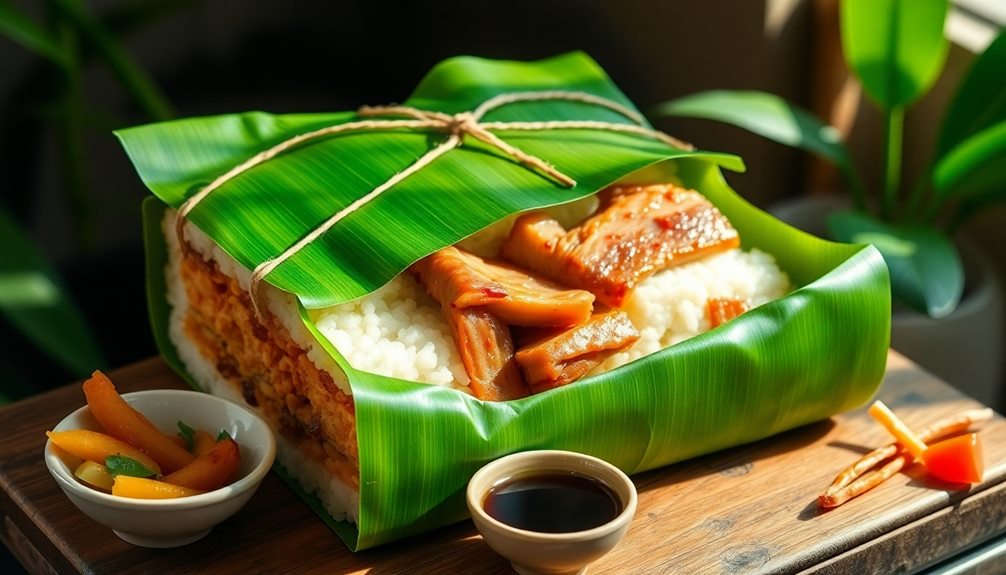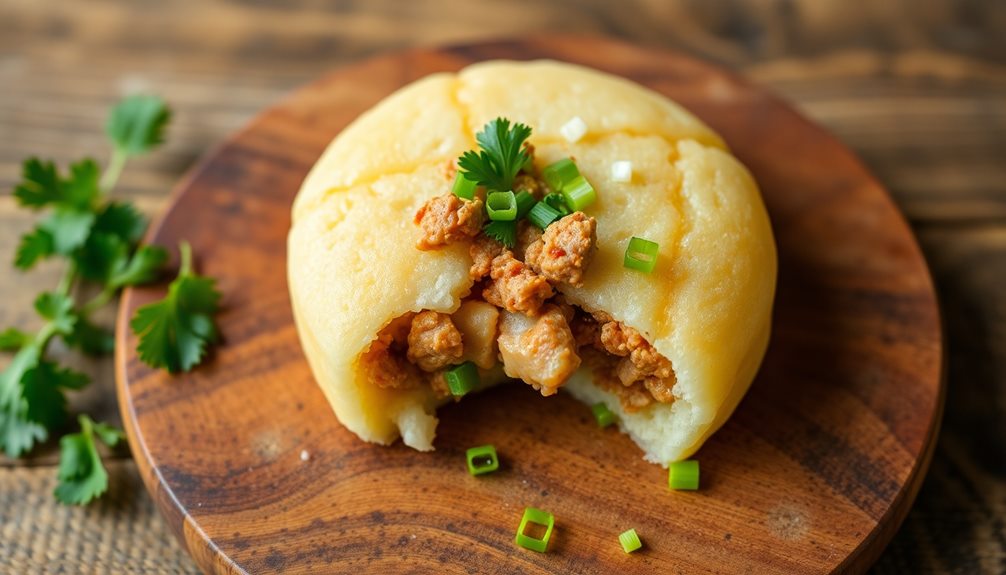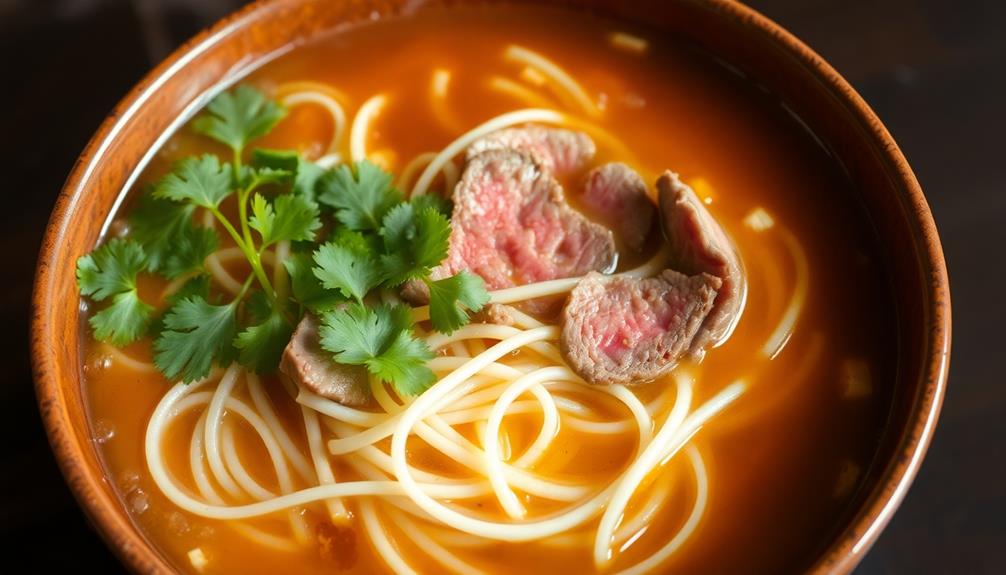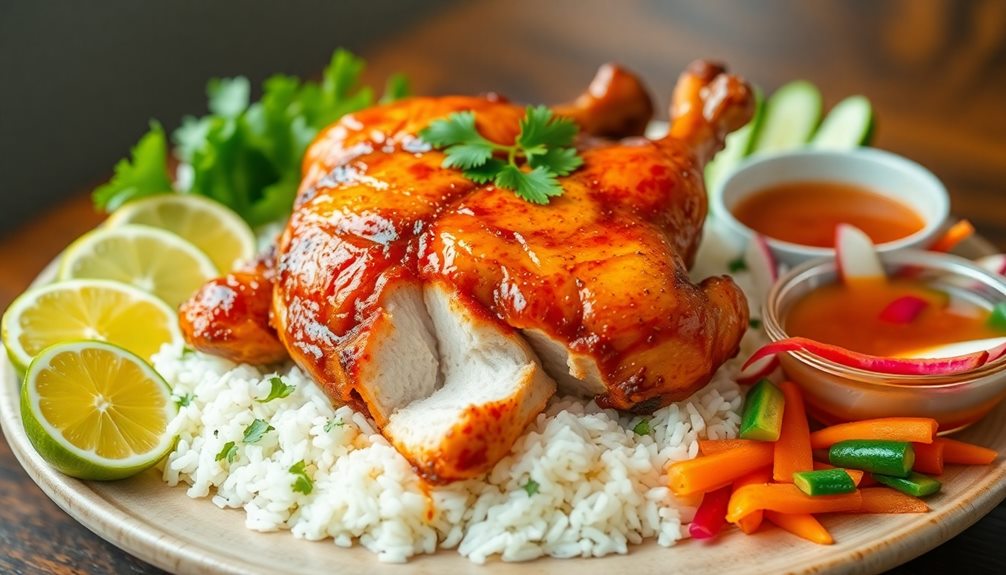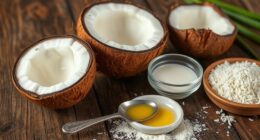Bánh Chưng and Bánh Tết are delicious Vietnamese rice cakes enjoyed during the Lunar New Year! Bánh Chưng is square, reflecting the Earth, while Bánh Tết is cylindrical, symbolizing the sky. They're made from glutinous rice, mung beans, and pork, wrapped in banana leaves, and steamed for several hours. This fun cooking process brings families together, creating a warm atmosphere of love and respect, especially for ancestors. After cooking, these cakes cool down and become perfect for sharing. If you've got an appetite for more tasty details about their history and cooking methods, there's lots more to discover!
Key Takeaways
- Bánh Chưng is square-shaped, symbolizing the Earth, while Bánh Tét is cylindrical, representing the heavens, both significant during Tết celebrations.
- Both rice cakes are made from glutinous rice, mung beans, and pork, showcasing traditional Vietnamese culinary practices.
- These cakes symbolize gratitude towards ancestors and are often shared among family and friends during Lunar New Year gatherings.
- The preparation involves soaking rice and mung beans, blending ingredients, wrapping in banana leaves, and steaming for several hours.
- Modern variations include vegetarian options and innovative fillings, reflecting contemporary tastes while honoring traditional recipes.
History
Vietnamese rice cakes, or "bánh," have a rich history that dates back over a thousand years. These delightful treats aren't just snacks; they're a big part of Vietnam's culture and traditions. Imagine a time when families gathered to make bánh together, sharing stories and laughter. That's the spirit behind these rice cakes!
One of the oldest types of bánh is bánh chưng, which symbolizes the Earth. People believe it represents gratitude toward ancestors and the importance of family. Then there's bánh tét, which has a similar meaning but is shaped differently, representing the sky. These cakes are often made during special occasions like the Lunar New Year, known as Tết.
As you dive into the history of bánh, you'll find many legends and tales that explain their significance. It's fascinating to learn how these cakes have been enjoyed for generations, handed down from grandparents to parents, and then to you!
Cooking Steps
To create delicious rice cakes, you'll need to follow a few essential steps. First, gather your ingredients. For Bánh Chưng, you'll need glutinous rice, mung beans, pork, and banana leaves. For Bánh Tét, the ingredients are similar, but you'll use cylindrical shapes instead. Don't forget the salt!
Next, soak the glutinous rice and mung beans in water for at least four hours. This step helps soften them, making them easier to cook.
After that, you'll want to prepare your filling. For Bánh Chưng, mix the pork with a sprinkle of salt and let it marinate. For Bánh Tét, you can use the same filling or get creative with sweet versions!
Now it's time to wrap! Use the banana leaves to create a neat package around your rice and filling. Secure everything tightly with string, making sure there are no gaps.
Once wrapped, boil the cakes in water for about six hours. The longer they cook, the tastier they become!
Step 1. Soak Glutinous Rice Overnight

Before you dive into making delicious Vietnamese rice cakes, you'll need to soak glutinous rice overnight. This step is super important because it helps the rice absorb water, making it soft and sticky. You'll want to grab about 2 cups of glutinous rice, which you can find at an Asian grocery store.
Start by rinsing the rice under cool water until the water runs clear. This washes away any dust or extra starch! After rinsing, place the rice in a bowl and cover it completely with water. Make sure there's enough water so the rice can soak properly.
Now, this is the fun part! You can let the rice soak overnight, which is usually about 8 hours. If you're eager and can't wait, soaking it for at least 4 hours will still work, but overnight is best for that perfect texture.
When morning comes, your rice will be nice and plump, ready for the next steps in your rice cake adventure. So, get excited! You're one step closer to creating tasty Bánh Chưng and Bánh Tét that everyone will love!
Step 2. Blend With Mung Beans

Now that your glutinous rice is soaked and ready, it's time to blend it with mung beans for that signature flavor and texture in your rice cakes.
First, you'll need to prepare your mung beans. If you haven't already, soak them in water for a couple of hours. This helps soften them up, making them easier to blend. Once they're nice and soft, drain them and set them aside.
Next, grab a food processor or blender. Add the soaked mung beans and a splash of water to help things along. Blend until you get a smooth, creamy mixture. You can add a pinch of salt to enhance the flavor!
Now, it's time to mix this mung bean puree with your soaked glutinous rice. In a large bowl, combine the two. Use your hands to gently fold them together, making sure every grain of rice gets coated with the delicious mung bean mixture.
It's okay to get a little messy! Keep going until it's well mixed, and you'll have a lovely blend ready for the next step in making your tasty Vietnamese rice cakes. Enjoy this part, as it's where the magic begins!
Step 3. Wrap in Banana Leaves

Wrapping your rice cake mixture in banana leaves is an essential step that adds flavor and keeps everything moist during cooking.
First, you'll want to choose fresh, green banana leaves. They should be flexible, so gently heat them over a flame or in hot water to make them easier to fold.
Next, cut the leaves into large squares, about 10 inches by 10 inches. Lay one square flat on your working surface. Spoon your rice mixture into the center, about a cup or so, depending on the size you want. Be sure to spread it out evenly!
Now, fold the sides of the banana leaf over the mixture, creating a neat package. You'll want to tuck in the ends tightly, so nothing spills out during cooking. Use kitchen twine or strips of banana leaf to tie your packages securely.
Repeat this process for each rice cake until you've used up all your mixture. It's a bit like wrapping a present, and it can be a lot of fun!
Once you've wrapped them all, you'll be ready for the next exciting step in making your delicious Vietnamese rice cakes!
Step 4. Steam for Several Hours

The key to achieving perfectly cooked Vietnamese rice cakes lies in the steaming process. Once you've wrapped your rice cakes in banana leaves, it's time to get steaming!
Start by filling a large pot with water, but make sure it's not touching the bottom of your steaming rack. Then, place the wrapped cakes on the rack, ensuring they're not crammed together. This allows steam to circulate around them.
Cover the pot with a lid and crank up the heat. You'll want to let them steam for about four to six hours. Yes, that's a long time, but it's worth it! As they steam, the aroma will fill your kitchen, and you'll feel the excitement building.
Check the water level occasionally to make sure it doesn't run dry; add more if needed.
When the time's up, carefully remove the lid—watch out for the steam! Gently lift out your rice cakes, and you'll see how they've transformed. They should look shiny and firm, ready for the next steps.
Enjoy this wonderful process, knowing that delicious treats await you!
Step 5. Cool Before Serving

After steaming, it's important to let your Vietnamese rice cakes cool down before serving. This step might seem simple, but it's really important for getting the best flavor and texture!
When you remove the cakes from the steamer, place them on a wire rack or a flat surface. Make sure they're not stacked on top of each other, or they might stick together as they cool.
Let them sit for about 30 minutes to an hour. This cooling time helps the rice cakes firm up, making them easier to slice and serve. Plus, it gives the flavors a chance to settle in, so each bite is delicious!
While you wait, you can prepare some tasty dipping sauces or side dishes to enjoy with your rice cakes.
Once they've cooled down, you can cut them into slices or squares. Serve them warm or at room temperature, and don't forget to share with family and friends!
Vietnamese rice cakes are a wonderful treat, perfect for special occasions or just a cozy gathering. So, get ready to enjoy your delicious homemade bánh chưng or bánh tét!
Final Thoughts
Vietnamese rice cakes, with their delightful textures and flavors, offer a unique culinary experience that reflects the rich culture of Vietnam. When you take a bite of Bánh Chưng or Bánh Tét, you're not just tasting food; you're enjoying a tradition that's been passed down through generations.
These cakes are often made for special occasions, like the Lunar New Year, and they bring families together in a celebration of love and memories.
Making these rice cakes can be a fun activity, too! You can gather your friends or family, roll up your sleeves, and create your own delicious versions at home.
The process is just as important as the final product. You'll learn about teamwork and the joy of sharing food with those you care about.
Frequently Asked Questions
What Are the Main Ingredients in Bánh ChưNg and Bánh Tét?
To make these traditional rice cakes, you'll need glutinous rice, mung beans, pork, and banana leaves. These ingredients create a delicious combination that's both savory and sweet, perfect for celebrating special occasions or enjoying as a treat.
How Long Do These Rice Cakes Last After Preparation?
After preparation, these rice cakes typically last about 2-3 days at room temperature. If you refrigerate them, they can stay good for up to a week, but freezing extends their shelf life even longer.
Can I Freeze Bánh ChưNg and Bánh Tét?
Yes, you can freeze them! Just wrap each cake tightly in plastic wrap or foil, then place them in an airtight container. When you're ready to enjoy, thaw them in the fridge overnight.
Are There Any Gluten-Free Options for These Rice Cakes?
Yes, there are gluten-free options available for rice cakes. You can look for varieties made with gluten-free flours like rice or tapioca. Always check the labels to ensure they meet your dietary needs.
What Is the Significance of These Cakes in Vietnamese Culture?
In Vietnamese culture, these rice cakes symbolize family unity, heritage, and respect for ancestors. You'll find them at celebrations, especially during Lunar New Year, where they embody tradition, love, and the sharing of good fortune.


